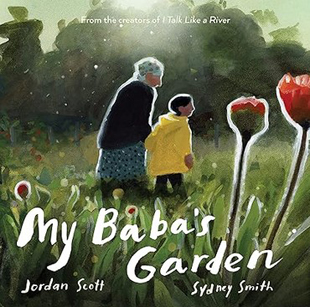What grandparents teach their grandchildren goes way beyond words. A gesture, a glance, a gentle embrace can show affection and even demonstrate profound truths, as this story shows.
The narrator and his grandmother — his Baba — do not share much language in common. She lives simply, "in a chicken coop beside a highway," where his father drives him every morning so that she can care for her grandson during the day. To communicate, she points and the boy nods. When he accidentally drops a bite of food that she has cooked for him, she picks it up, kisses it, puts it back in his bowl, and gently squeezes his cheeks. When he asks why she collects worms during rainstorms and brings them back to her garden, she traces all the lines in the palm of his hand.
Tender and evocative, both the text by poet Jordan Scott and the illustrations by Kate Greenaway Medal winner Sydney Smith bring the bond between these two fully alive, whether Baba is getting her grandson ready for school, sharing garden harvest with him, or, eventually, moving into the boy's home as her health begins to fail, giving him a chance to reciprocate the loving care she's given him. The pictures are stunningly beautiful -- for instance, rays of light streaming down from clouds on the lake that the father and son pass on the way to Baba's house -- and impeccably interconnected. The stick-figure drawing we see of Baba at her house becomes, on a subsequent page, the picture the boy is sketching in the car's back seat.
Perhaps the heart-aching wonder of this book comes from its deep roots in Jordan Scott's personal history. In an opening note, he speaks of his grandmother and her family's suffering during World War II, her treasuring even soap shavings and storing food "in every nook and cranny." He explains the palms tracing: "She was telling me that when worms dig, they help increase water and air that gets into the soil and also provide nutrients."
The backdrop of suffering and hint of melancholy give this book a feeling of eternity -- not of living forever, but of living compassionately in the fullness of time, moment by moment. We highly recommend this book for four-to-eight-year-old readers and for anyone wanting to allow love to ease the sadness this world often brings.
